|
Related FAQs: Fishes of
Hawai'i, Articles on: The Best
Butterflyfishes of Hawai'i, Triggerfishes of
Hawai'i,
Related Articles: Introduction to Fishwatcher's Guide
Series Pieces/Sections, Scott's Trip to
Maui/Hawai'i, Holualoa property,
A Fishwatcher's Guide to the
Marine Fishes of Hawai'i
Part 1 of 5, To: Part 2,
Part 3, Part 4,
Part 5
|
.JPG)
|
|
Bob Fenner
|
Along the trail at
Makalawena Beach on Hawaii's big island.
|
Bigger PIX:
The images in this table are linked to large (desktop size) copies.
Click on "framed" images to go to the larger size. |
.JPG)

.JPG)

.JPG)
 |
Family/Species Accounts of Fishes Of Tropical Hawai'i
Sharks, Subclass Elasmobranchii. Of the forty species of
sharks found in Hawai'i, half are deepwater organisms, and all are
too large for aquarium use. Two species do come into the trade every
now and then, albeit by accident. Juvenile Black Tipped Reef Sharks,
Carcharhinus melanopterus (3) and more infrequently White-Tipped
Reef Sharks, Triaenodon obesus (3), are caught "by
accident" from time to time by haplessly swimming into a tropical
fish collectors barrier net. Such "bonus" catches are
gratefully gathered and sold at high price (a few hundred dollars) to
wholesalers.
Both species reach several feet in length, so these sharks should
only be exhibited in Public Aquariums. If you must try a marine shark,
please consider one of the smaller Cat Shark (family Scyliorhinidae)
(2) and Bamboo Shark (family Hemiscyliidae) (2) species offered in the
trade; and do your husbandry homework in advance.
| Carcharhinus amblyrhynchos
(Bleeker 1856), the Grey Reef Shark. Indo-Pacific, including the
Red Sea, to the Tuamotus. Dark gray to bronze above, white below.
Caudal and underside tips of pectorals, pelvics with
conspicuous black margins. Males to eight feet, females to five.
These photographed in Moorea, Fr. Polynesia. |
 
|
| Carcharhinus melanopterus
(Quoy & Gaimard 1824), the Blacktip Reef Shark. Indo-West to
Central Pacific, including the Red Sea. To six feet in length.
Litters of 2 to 5 pups. Offered in the aquarium trade
regrettably all too often. Requires very large systems. Public
Aquarium photo. |
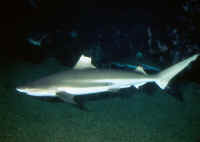
|
| Triaenodon obesus (Ruppell
1837), the Whitetip Reef Shark. Indo-Pacific, including Red Sea and
eastern Pacific. Here sitting under a ledge off Maui in the
Hawaiian Islands, and below, cruising over the reef in Fiji. To
about six feet in length. Only dangerous if molested. A
typical view of one sitting on the bottom in Hawai'i at right,
and one swimming in Fiji. |
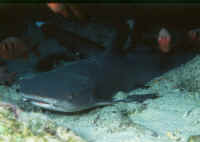 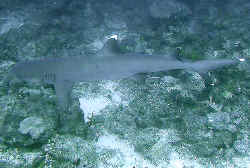
|
| Sphyrna lewini (Griffith
& Smith 1824), the Scalloped Hammerhead. Found around the world
in cool to tropical waters. To thirteen feet in length. This
visitor off Hurghada, Egypt, Red Sea was about eight feet
long. |
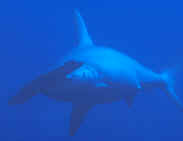
|
Rays
| Manta birostris (Donndorff 1798), a/the
Manta Ray. The paddle-like extensions on the head used for
directing food into this filter feeders mouth. Third largest fish
species at more than 6.7 meters in width, two tons in weight.
Circumtropical. This one at a cleaning station in Australia. |

|
Ecotype for both species: Uncommon in all marine habitats, shallows
to open water.
Eels
Morays, family Muraenidae.
The Hawaiian Islands are the land of the Puhi (native lingo for
eels). According to some authors these snake-like fishes not only make
up the biggest predator pressure on the reefs, but weigh in as the most
fish-mass there as well.
Indeed there are thirty eight (not a typo) species of moray eels in
Hawai'i, only the wrasses have more species here. Most get too big,
mean (eat their tankmates, bite you), and apt to jump out for aquarium
use, but two of the muraenids deserve their captive popularity. The
Zebra Moray, Gymnomuraena zebra (1) and Snowflake Moray,
Echidna nebulosa (1), lack the fierce dentition of their
piscivorous kin, being specialized crustacean crushers, preferring to
eat crabs in the wild. The Zebra can attain some five feet in length,
and the Snowflake more than two, but they generally are much smaller in
aquarium use.
Though I don't endorse the use of the many other morays of
Hawai'i for the above stated reasons, we should mention some of
them as they are offered in the trade. The first and most commonly
offered "variety" is the notorious "miscellaneous"
Hawaiian Moray eel; not a species, but several. Be careful here. Some
of these Morays grow to several feet and thicker than your thigh. You
want to know exactly which species you're dealing with and its
natural history. Of the "miscellaneous" category, you'll
find the Tiger Moray, Scuticaria tigrina, Whitemouth Moray,
Gymnothorax meleagris, Yellowmargin Moray, G.
flavimarginalis, among others. All (here we go again) get big,
nasty, and jump or push their way out of aquariums, and therefore rate
a (3).
|
The Snowflake, Starry, or
Diamond-Backed Moray, Echidna nebulosa (Ahl 1789) is a
fabulous aquarium species; small, compatible with other fish
species and adaptable to captivity. It is certainly the most
peaceful, outgoing and desirable moray species. To about thirty
inches total length. Base color of silver gray with black and
yellow "snowflakes" randomly sprinkled over the lower
body.
|
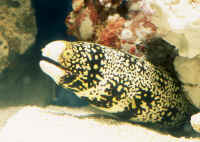
|
|
Dragon morays, Enchelychore
pardalis from Hawaii are striking with white bodies and
variegated black, yellow and red markings. Their name derives
from the presence of elongate, pointed jaws and long posterior
nostril tubes. They command a high price for their beauty and
adaptability, and are worth it.
Attractive to a lesser degree, but frequently seen in the trade,
the Mediterranean Muraena helena reaches the about half
the Dragon Moray's length, about two feet.
|
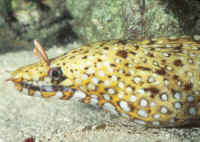
|
| Gymnomuraena zebra, the aptly named Zebra
Moray is a slow-moving chocolate black with vertical white striped
beauty. (photo). The suitability for aquaria of the species is
reflected in longevity records. Our old service company had some in
rentals for fifteen years. There are twenty-something year
citations. |

|
| Gymnothorax eurostus
(Abbott 1861), Stout Moray. Light brown with gold spots, tubular
nostrils. To about 2 foot in length. Indo-Pacific. Most common moray species in nearshore
Similar to the also common Yellow-Margin Moray, but with a more
pointed snout and dark spots on the forward half of the body.
Hawaii pix. |
 
|
| Gymnothorax
flavimarginatus (Ruppell 1830). The Yellow Margin Moray, or
puhi paka in Hawaiian. Black spot on gill opening, yellowish green
margin on the fins. Indo-Pacific. To four feet in length but
girthy. Common in Hawaii where it is often "tamed" by
dive companies. Hawaii pix. |
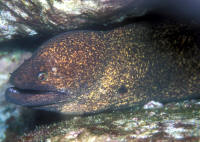
|
| Gymnothorax javanicus
(Bleeker 1859), Giant Moray. To ten feet, 3 meters in length.
Indo-Pacific; Red Sea, East Africa to Hawai'i. Feeds
principally on fishes, secondarily on crustaceans. Largest Moray
species according to Fishbase. Shown here in the Red Sea and
Fiji. |
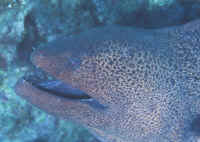 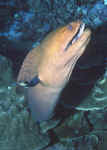
|
| Gymnothorax meleagris
(Shaw & Nodder 1795), the White Mouth Moray. Brown to black
with numerous white spots. Dark spot around gill opening.
Indo-Pacific. Most common Hawaiian puhi/moray. To about forty
inches in length. Hawai'i images of small (ten inch or so) and
adult (three feet) individuals. |
 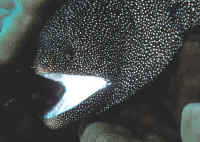
|
| Gymnothorax
rueppelliae (McClelland, 1844), the Banded Moray. Indo-Pacific:
Red Sea and East Africa, to the Hawaiian, Tuamoto, and Marquesan
islands. Feeds on fishes and crustaceans, mainly at night. Wary and
often aggressive. Grows to roughly 31 inches (80cm). Bands more
prominent in juveniles, fade as the animal gets older. Also
distinctive brown spot at the back of the mouth, helps ID this eel.
This one hiding in the coral at night, of Kona,
Hawai'i. |
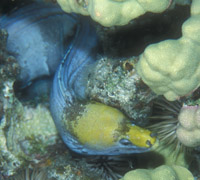 |
| Gymnothorax undulatus (Lacepede 1803), the Undulated Moray.
Indo-Pacific; East Africa to the French Polynesia, Hawai'i. To
five and a half feet in length. This one in
Hawai'i. |
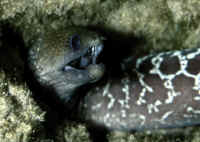
|
| Scuticaria tigrina Lesson
1830, the Tiger Reef Eel. Indo-Pacific; East Africa to the tropical
eastern Pacific, including Hawai'i. To 120 cm. in length.
Secretive, nocturnal. Found foraging between rocks at night.
Aquarium photo. |
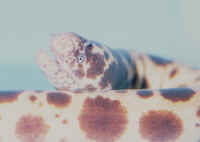
|
Oh yes, there is one other "non-miscellaneous" large moray
worth noting. The Dragon Moray, Enchelycore pardalis (formerly
Muraena pardalis) we'll give it a (2). Though it shares the
same traits as other large Hawaiian muraenids, due to its high cost
perhaps, aquarists tend to provide it better care and keep it
longer.
Ecotype: Shallow to mid-depth reefs to bays, rocky habitats. Hide in
recesses by day, coming out at night to feed.
Other Eels: Occasionally Snake Eels (family Ophichthidae),
Conger Eels (family Congridae) and other species of families of true
eels are offered out of Hawai'i. They should not be. Most require
very specialized care and die quickly (3).
| Conger cinereus Ruppell 1830, the Mustache
Conger. Indo-Pacific. To four feet in length. Found in holes in
rocky caves near the bottom. Looks like a sea monster, but is a
gentle giant. Hawaii pic during the day. |
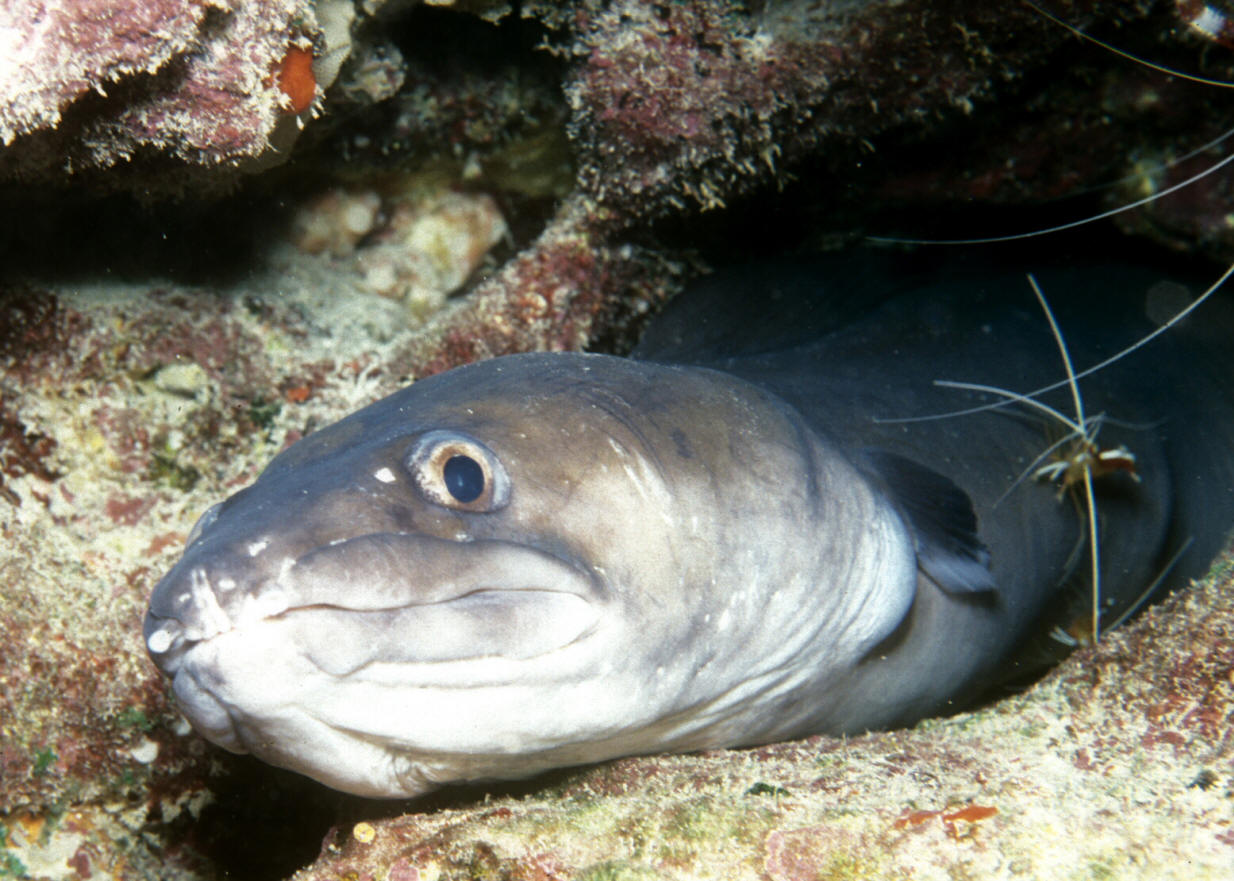
|
Lizardfishes, Family Synodontidae: 17 species described from HI, some
from deeper than divers care to go. Found on or under the sand where
they wait in stealth to grab small fishes, crustaceans, squids for
food. Sometimes follow divers about apparently for opportunities of
"light-stunned" fish prey by flash photographers.
| Saurida flamma Waples 1982, the Orangemouth
Lizardfish. To 13 inches. Hawai'i, Australs and Pitcairn
Island. Hawai'i pix taken at night off of Kailua showing the
orangish lower jaw. |
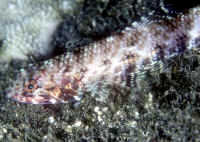 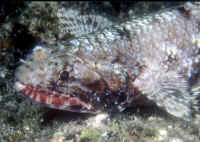
|
| Synodus binotatus Schultz 1953, the Twospot
Lizardfish. Dual small black spots on the snout. To about 7
inches/18 cm. Indo-Pacific. Here in HI. |
.JPG)
|
|
Synodus variegatus (Lacepede 1803), the Reef
Lizardfish. Most common species (out of seventeen) in
Hawai'i. To more than ten inches in length. Indo-Pacific.
Kailua-Kona, HI and Fiji images
|
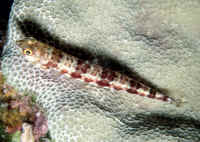 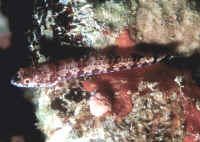
|
The Frogfishes or Anglers, Family Antennariidae.
At least five of the seven species of cryptic, globular Frogfishes
found in Hawai'i are sold in the trade, almost always within three
designations: (Assorted) Hawaiian Angler, (Assorted) Colored Hawaiian
Angler, and Dwarf or Pygmy Hawaiian Angler. The first two categories
are generally "plain" (brownish, mottled) to more
"colorful" (red, yellow, orange, black, gray) Commerson's
Frogfish, Antennarius commersonii, though other species are
mixed in. The smaller (a few inches) are principally just juveniles of
the larger species but you may happen upon an occasional
"true" miniature species like Randall's, A.
randalli and the Reticulated Frogfish, Antennatus tuberosus.
I'll rank all the Frogfishes (2) for their historical losses due to
rough handling, and either starvation in captivity or propensity for
swallowing other fish tankmates (even larger than themselves). If
you're going to keep an angler (one to a tank, because they will
also eat each other), take care in selecting fellow livestock (too big
to be sucked down), and providing adequate food (generally live, but
not all consumed by the other livestock).
Ecotype: Hidden by shape, color, fleshy appendages, resting on rocky
bottoms, "waiting" for a meal to come by or
"fishing" for it.
Part 1 of 5, To: Part 2, Part 3, Part 4, Part 5

